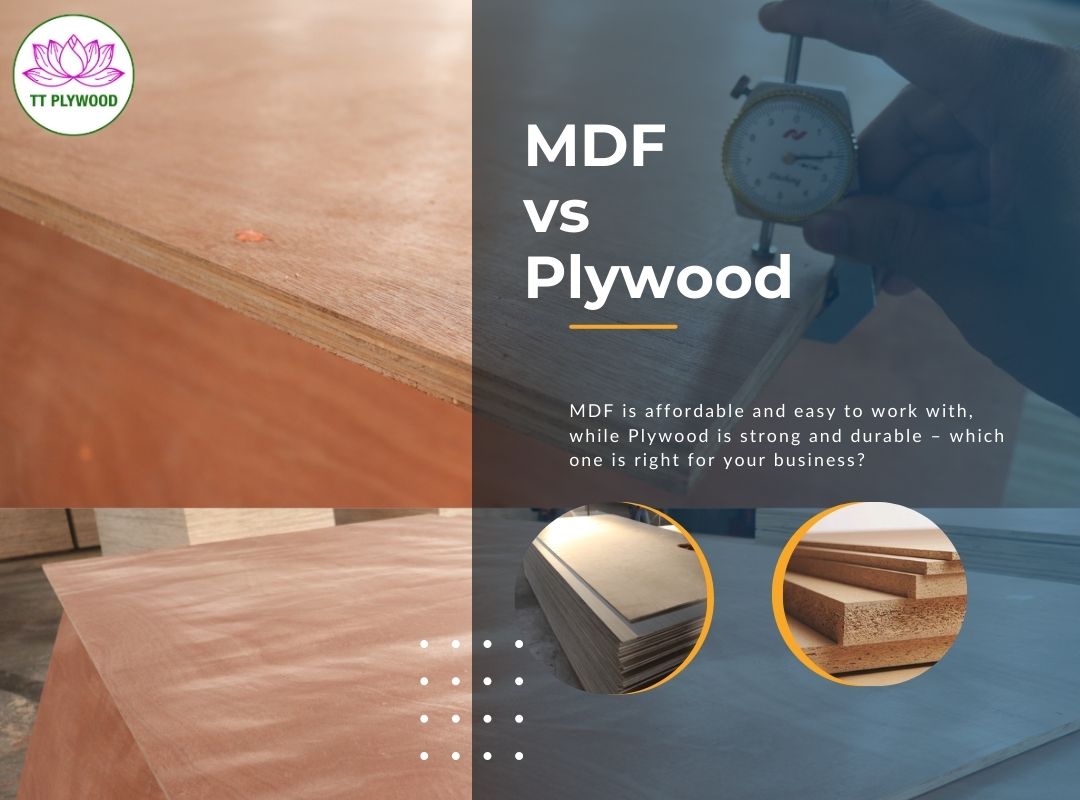-
-
-
Total payment:
-

Plywood vs. MDF – Which One is Best for Your Business?
Posted by Thanh Uyên at 19/02/2025
Choosing the right material for furniture, cabinetry, and construction is crucial for businesses looking for durability, cost-efficiency, and quality. Two of the most widely used engineered wood products are Plywood and MDF (Medium-Density Fiberboard).
In this article, we’ll compare Plywood vs. MDF, analyzing their composition, durability, cost, applications, and advantages, helping businesses decide which material suits their needs best.
1. What is Plywood?
Plywood is an engineered wood product made by gluing together multiple thin layers of wood veneer. These layers are arranged perpendicularly to each other, creating a strong and stable material that resists warping and cracking.
🔹 Key Features of Plywood:
- High Strength & Durability – Ideal for heavy-duty applications.
- Moisture-Resistant Options – Available in marine-grade plywood for wet conditions.
- Multiple Grades & Finishes – Comes in softwood, hardwood, and birch plywood for different needs.
- Lightweight Yet Strong – Easier to transport and install than solid wood.
🔹 Disadvantages of Plywood:
- More expensive than MDF.
- Requires veneers or laminates for a smooth surface finish.
- Quality depends on glue and manufacturing process.
2. What is MDF (Medium-Density Fiberboard)?
MDF is made by breaking down wood fibers, combining them with resin and wax, and compressing the mixture into dense, uniform sheets under high pressure.
🔹 Key Features of MDF:
- Smooth & Even Surface – Perfect for painting and laminating.
- Affordable Alternative to Plywood – Cost-effective for budget-friendly projects.
- Easy to Cut & Shape – Ideal for intricate designs and carvings.
- Consistent Density – No knots or voids like in plywood.
🔹 Disadvantages of MDF:
- Less durable than plywood, prone to swelling if exposed to moisture.
- Heavier than plywood, making it difficult to handle.
- Contains formaldehyde (if not E0 or E1 certified), which may raise safety concerns.
3. Strength & Durability – Which One Lasts Longer?
|
Feature |
Plywood |
MDF |
|
Strength |
✅ High – Suitable for heavy loads & construction |
❌ Moderate – Weaker under stress |
|
Durability |
✅ Resistant to warping & impact |
❌ Can chip & crack easily |
|
Moisture Resistance |
✅ Available in waterproof grades |
❌ Absorbs moisture, swells easily |
|
Load-Bearing Capacity |
✅ Suitable for structural applications |
❌ Not ideal for weight-bearing uses |
Verdict:
If strength, longevity, and moisture resistance are essential, Plywood is the better choice for furniture and structural applications. MDF is suitable for decorative and interior use where moisture exposure is minimal.
4. Aesthetic Appeal – Which Material Looks Better?
|
Feature |
Plywood |
MDF |
|
Surface Finish |
❌ Requires veneer, paint, or laminate |
✅ Naturally smooth for painting |
|
Wood Grain Appearance |
✅ Has a natural wood look |
❌ Needs a laminate or veneer to mimic wood |
|
Customization |
✅ Can be stained for natural look |
✅ Easy to carve and design |
Verdict:
For natural wood aesthetics, Plywood is the superior option. If you need a smooth, painted surface, MDF works best.
5. Workability – Which Material is Easier to Cut & Install?
|
Feature |
Plywood |
MDF |
|
Ease of Cutting |
❌ Harder to cut cleanly |
✅ Easier to cut into detailed designs |
|
Edge Finishing |
❌ Can splinter without proper tools |
✅ Smooth, clean edges |
|
Drilling & Screwing |
✅ Holds screws well |
❌ May strip or crack around screws |
Verdict:
If intricate carving or custom designs are required, MDF is easier to work with. However, for stronger screw-holding capability and stability, Plywood is the better choice.
6. Cost Comparison – Which One is More Budget-Friendly?
|
Feature |
Plywood |
MDF |
|
Material Cost |
❌ More expensive |
✅ More affordable |
|
Installation Cost |
✅ Lower due to lightweight structure |
❌ Higher due to heavy weight |
|
Long-Term Value |
✅ Longer lifespan |
❌ May need replacement sooner |
Verdict:
MDF is cheaper upfront but may require more maintenance. Plywood has a higher initial cost but offers better long-term value.
7. Best Applications – When to Use Plywood or MDF?
|
Application |
Plywood |
MDF |
|
Kitchen Cabinets |
✅ Yes |
❌ Not recommended due to moisture risk |
|
Furniture Frames |
✅ Yes – Strong & durable |
❌ No – Weaker for weight-bearing |
|
Decorative Wall Panels |
❌ Requires veneer or stain |
✅ Ideal for smooth, painted walls |
|
Construction & Flooring |
✅ Best choice |
❌ Not durable enough |
|
Speaker Boxes |
❌ Not acoustically optimized |
✅ Best for sound clarity |
Conclusion – Which One Should You Choose?
If you need a strong, durable, and moisture-resistant material for long-term use, Plywood is the best option. However, for budget-friendly and smooth-finish applications, MDF is a great choice.
For businesses seeking high-quality plywood at competitive pricing, TT Plywood from Vietnam offers the perfect balance of strength, aesthetics, and affordability.
✔ Long-lasting quality
✔ Cost-effective solutions
✔ Trusted by global businesses
8. Why Choose TT Plywood from Vietnam?
When selecting high-quality plywood, businesses worldwide trust TT Plywood from Vietnam. Here’s why:
🔹 Superior Quality with Competitive Pricing
- Manufactured using high-quality tropical hardwoods & birch for durability.
- More affordable than Baltic Birch Plywood, while maintaining strength.
🔹 Sustainability & Eco-Friendly Production
- FSC & PEFC Certified – Ethically sourced wood.
- CARB P2, E0, and E1 Standards – Low formaldehyde emissions for safety.
🔹 Customization & Global Export Expertise
- Multiple thicknesses, sizes, and finishes available.
- Trusted by businesses in the USA, Canada, South Korea, and Europe.
- Reliable logistics & fast delivery worldwide.
📩 Looking for a trusted plywood supplier? Contact TT Plywood today!
📧 info@ttplywood.com | 🌍 www.ttplywood.com










